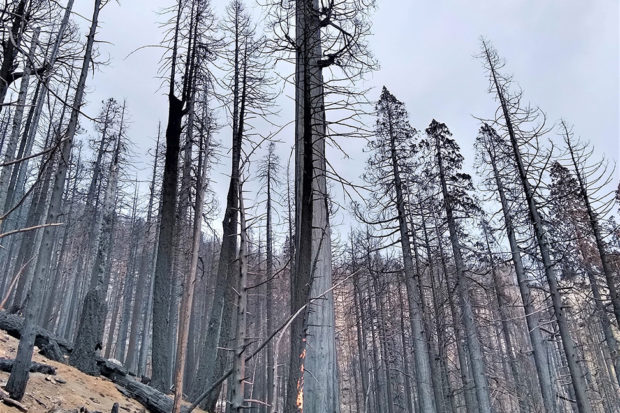
By Vic Bedoian
The 2020 SQF Complex Fire in the southern Sierras scorched more than 176,000 acres in the Giant Sequoia National Monument and the adjacent Sequoia National Park. Now, a report compiled by federal scientists indicates far more of the iconic redwoods might have been killed than previously thought.
Some 30%–40% of all the giant sequoias within the fire’s footprint were incinerated by the severity of the flames. Researchers explain that the intensity of the fire was brought on by drought conditions, fire-prone undergrowth and a legacy of fire suppression, together with climate warming, stressing the entire ecosystem.
The devastating Castle Fire in the southern Sierra Nevada last year might have killed 31%–42% of all the large giant sequoias in the footprint of that blaze. A National Park Service report says that translates into a stunning loss of 7,500–10,600 large giant sequoias—trees that are more than four feet in diameter. That’s 10%–14% of the entire population across their range along the western slope of the Sierras.
The research is the work product of scientists across several federal agencies. The draft report still needs more research and will be peer-reviewed, but the findings so far are troubling. Christy Brigham, chief of resource management and science for the Kings Canyon and Sequoia national parks, is the report’s lead author, and even she is shocked by what has been learned.
“I was definitely surprised and I think all of the people who contributed to this report and who know giant sequoias, and who know how fire resilient and fire-adapted these trees are, were astounded by these numbers.”
The draft report is a collaborative project that employed multiple scientists and multiple data sources from the U.S. Geological Survey, the Forest Service and the Save the Redwoods League. To derive their damage estimate, they combined satellite imagery before and after the fire, with ground-based data gathered from previous high-intensity fires.
Brigham notes that fires and climate change are changing the ecology of giant sequoia groves. “My initial takeaway from this preliminary analysis is based on satellite data. As we get in the field, we’ll get better numbers, but even these preliminary numbers are telling us that the nature of wildfire in the Sierra Nevada has changed.
“And [with] this new wildfire, there is an incredible threat to the persistence of these giant sequoias-these large thousand-year-old trees that we love so much.”
Brigham indicates that researchers were taken aback by the severity of the inferno. Even though giant sequoias are adapted to withstand wildfires of varying intensity, the Castle Fire engulfed them in walls of high-intensity flames.
“In some of these high severity areas, the fire was hot enough that it incinerated all the needles and left only charred sticks, giant sequoia sticks,” says Brigham.
“They’re large in area. There’s no living tree in that area, and that area is many, many acres in size. If there are no seedlings in those areas now, where will the seedlings come from? They normally come from cones on the living trees.”
She describes vast burned areas without any cones or seeds present. Even more disturbing, researchers discovered some sequoias had been killed in moderate and even low-intensity fire zones.
Conditions leading up to the ferocious 2020 fires had been building over the past century. Fire suppression has resulted in a tangle of undergrowth and forest floor litter that’s ripe for a lightning strike. Then came the exceptional five-year drought beginning in 2012, which hit hardest in the southern Sierra, home to most of the Sierra’s giant sequoias.
Brigham says that the big trees could survive the stress of climate change on their own. But the combined impacts of fire, fuels and climate change are delivering a life-threatening blow to these groves.
“Climate change made that drought more severe than past droughts, and climate change and the hot weather and the dry winters are continuing to stress these trees and make all of the vegetation and fuels drier and more liable to burn at high intensity and generate these crazy new fires,” said Brigham. “So the interaction between climate change and fire is very serious for us in the Sierra Nevada.”
There is also concern about the current drought conditions. Brigham explains that giant sequoia seedlings are not that drought tolerant and could die over this hot, dry summer. And she warns that, due to changing conditions, the forest might not recover the way it has in the past.
Sequoia managers in all the burned areas will be trying to learn how many trees were actually killed, what’s left on the landscape and what kind of regeneration they will undertake. In doing so, the park service is partnering with other conservation agencies and organizations to help rescue giant sequoia country.
*****
Vic Bedoian is an independent radio and print journalist working on environmental justice and natural resources issues in the San Joaquin Valley. Contact him at vicbedoian@gmail.com.

